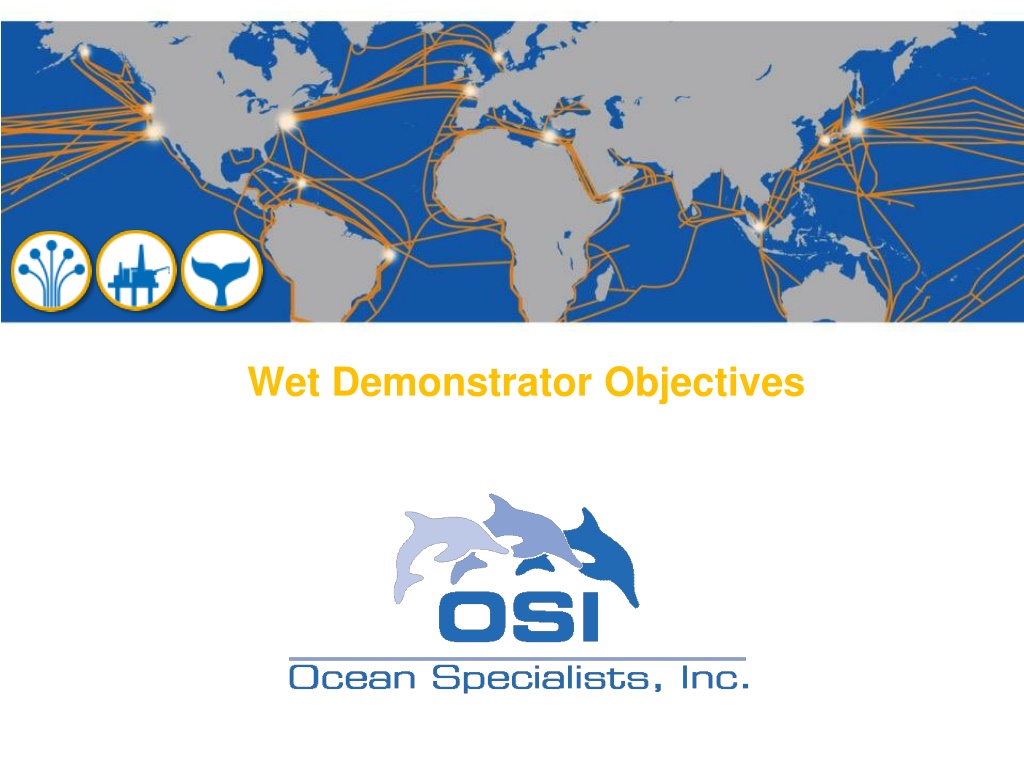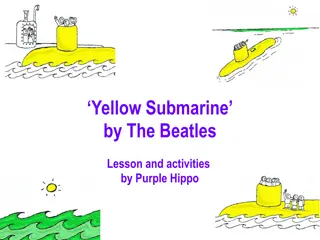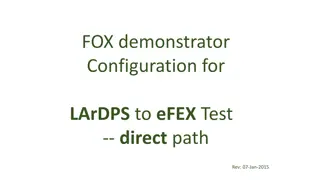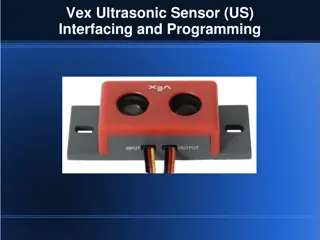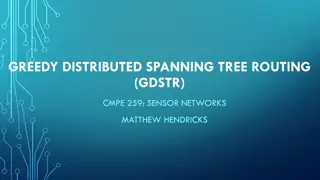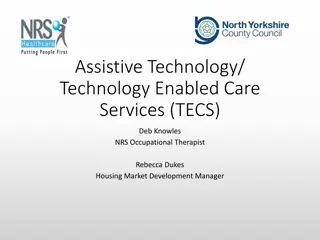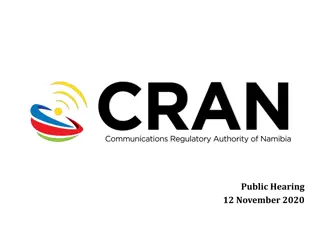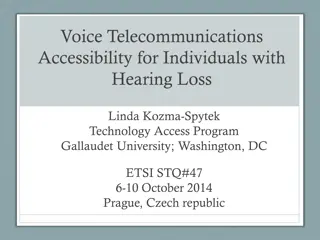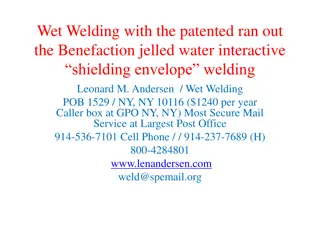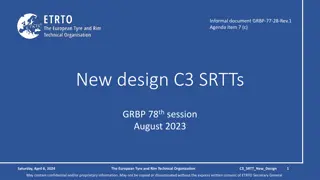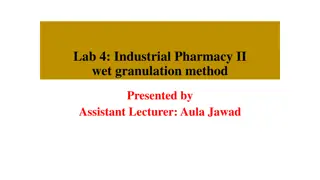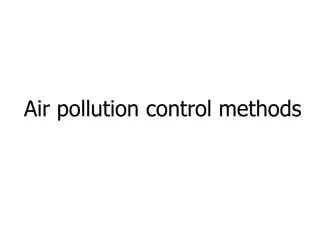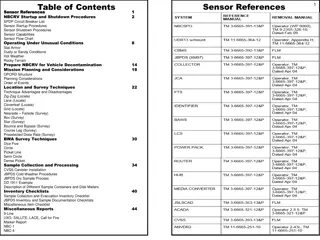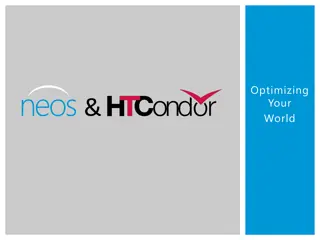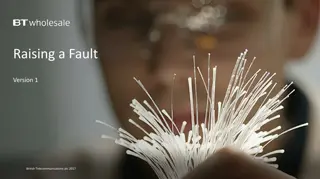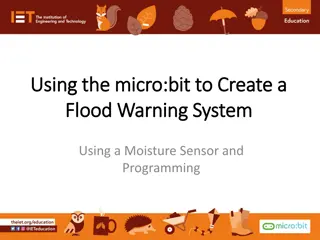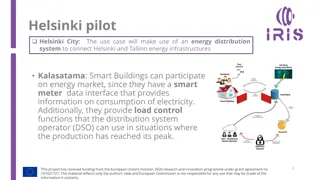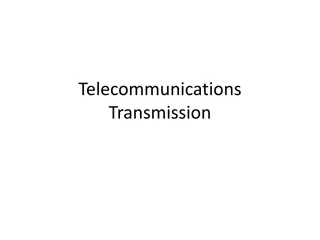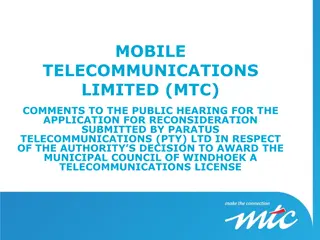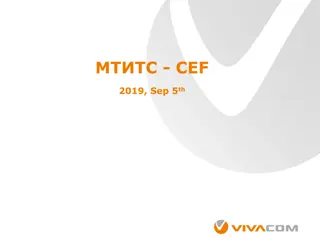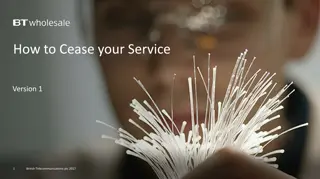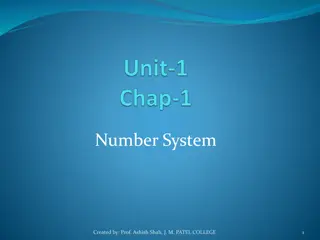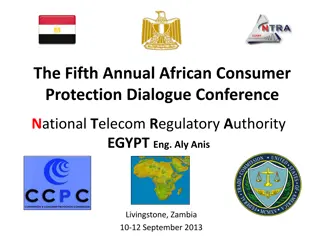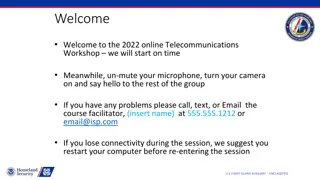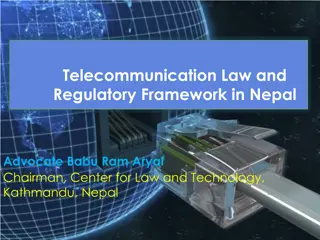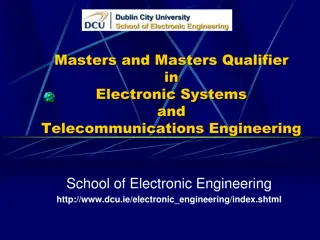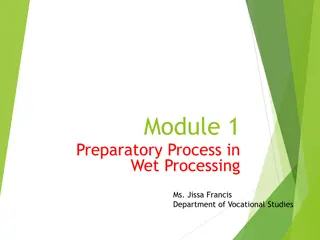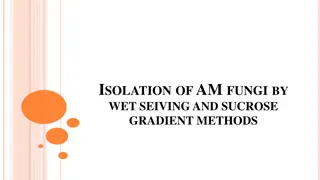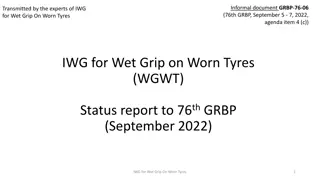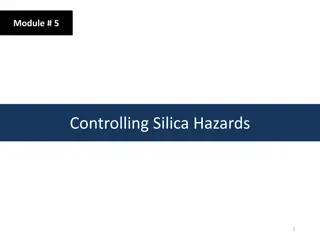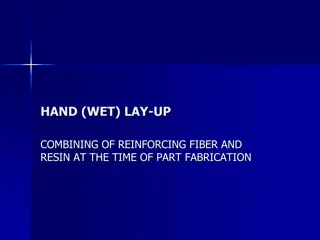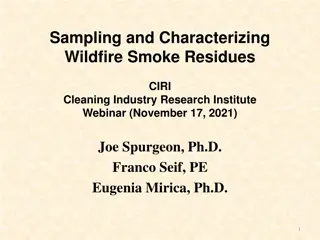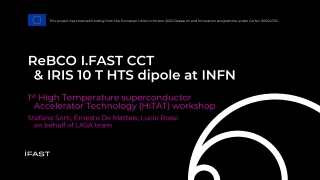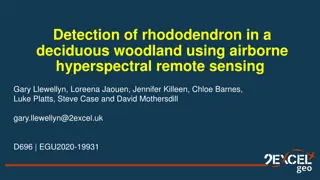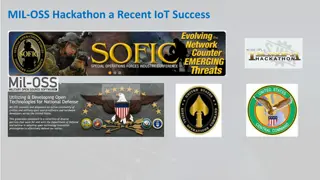Wet Demonstrator Objectives - Sensor-enabled Submarine Telecommunications System
This content discusses the objectives and features of a sensor-enabled submarine cable system, highlighting the capabilities and requirements for incorporating sensors along the cable. It emphasizes the importance of demonstrating the installation and accuracy of sensors in a real-world scenario, ensuring their seamless integration with telecommunications functions. The wet demonstrator objectives aim to validate assumptions regarding sensor orientation and deployment within the submarine cable system.
Download Presentation

Please find below an Image/Link to download the presentation.
The content on the website is provided AS IS for your information and personal use only. It may not be sold, licensed, or shared on other websites without obtaining consent from the author. Download presentation by click this link. If you encounter any issues during the download, it is possible that the publisher has removed the file from their server.
E N D
Presentation Transcript
A Brief History Functional Requirements First Draft Wet Demonstrator Scope First Draft Singapore Workshop Discussions General Requirements Draft to ITU July 2014 July 2014 Oct 2014 Feb 2016 2
Submission to ITU SG15 Establishes criteria for Sensor performance General capabilities: reliability, design life, environment, repair Operational requirements: error rate, latency, calibration, management Does NOT impose requirements on: Power delivery Communications How to build it Compliance with this Recommendation is voluntary. 3
Features of a sensor-enabled submarine cable system A sensor-enabled submarine cable system incorporates temperature, pressure and three-axis acceleration sensors at regular intervals along the cable. Sensor sets are nominally located once per repeater span, however other arrangements may be considered. Sensor sets shall be no more than 150 km apart. The system shall provide continuous power for the sensors and a means of transmitting data to one or more shore stations. The presence of sensors shall not preclude the use of branches, fixed OADM or ROADM. To the extent feasible, branch cable segments should also be equipped with sensors. 4
Capabilities of a sensor-enabled cable system The presence of sensors and the sensor subsystem shall have no net impact on the performance of telecommunications functions. Any allocation to the system performance budget resulting from the sensors or sensor subsystem shall be identified. The addition of sensors and the sensor subsystem shall have negligible impact on the availability of telecommunications functions. Any unavailability resulting from the presence of the sensors and sensor subsystem shall be identified. The design life of the sensor subsystem shall be ten years or greater. Sensor failures or sensor subsystem failures that have no affect on telecommunications functions will not be repaired. The sensors and sensor subsystem shall be compatible with conventional installation methods including, but not limited to, cable transport, cable and repeater storage on vessels, linear cable engines, three meter sheaves, plough burial, ROV burial and jetting. 5
Wet Demonstrator Objectives - Science Demonstrate the ability of sensors to be installed as part of a submarine telecommunications system Demonstrate the accuracy and usefulness of the sensor data when the sensors are deployed in a realistic manner Prove the assumptions related to sensor orientation and direction when laid as part of a cable system 6
Wet Demonstrator Objectives - JTF Provide baseline requirements that will facilitate continued discussion Maintain and strengthen interaction between interested parties Establish credibility needed to solicit more substantial resources from governments, NGOs, and industry 7
Wet Demonstrator Objectives - Suppliers Encourage system suppliers to allocate modest resources to early development stages Allow system suppliers to consider suitability of existing product lines 8
Wet Demonstrator Engineering Goals Sensors can be integrated into the cable system; Sensors can survive deployment stresses; Data can be collected and transmitted to shore; Data will provide value to science, and The system can continue to operate for months or years. 9
Configuration Requirements Each sensor set shall consist of one temperature sensor, one pressure sensor, and one three-axis accelerometer meeting the performance parameters provided in the Functional Requirements. Sensors shall be housed in or placed adjacent to a cable body that matches the physical and mechanical characteristics of a repeater housing. The submarine cable shall be a conventional [12mm], 17mm, 20mm or 21mm type suitable for the expected deployment conditions such as Lightweight (LW) or Lightweight Protected (LWP), or a cable armor type that is typically used for repeater tails. Power and communications shall be provided to the sensors. Note, however, that the power feeding and communications methods are not required to be similar to a conventional cable system and may be specific to the wet test. Note: It is expected that each supplier will demonstrate full integration of the sensors into their repeaters through appropriate qualification and sea trials at a later stage of development. 10
Basic Configuration Scope of Wet Demonstrator Wet-mate connector Test Facility or Cabled Ocean Observatory Adaptation Device (if required) 6-50km Sensor Set LW or LWP Lead-in cable (if required) 50-100m 6-50km 6-50km Sensor Set Sensor Set End cable and seal Ground rope and anchors 11
Connection to Observatory The wet test will be laid in an area of seabed supported by a cabled observatory The observatory shall agree to make the data from the wet test available to interested parties for review and verification The wet test shall include a suitable wet-mate connector for connection to a cable observatory. The wet test shall include any necessary adaptation to convert power received from the cabled observatory to power needed for the sensors. The wet test shall include any necessary adaptation to connect the sensors and the wet test system to the communications interface provided by the cabled observatory. 12
Installation The wet test shall be laid using conventional cable lay equipment At least one sensor location shall be visually inspected by ROV after installation. The wet test cable will be laid at typical speed for repeater installation. No attempt will be made to reduce loads on the instrument housing. 13
Criteria for Success All sensors operational following installation 99.99% availability of sensor data over test period No more than one sensor of each type failing over a six month period Successful validation of sensor data based on agreed qualitative and quantitative criteria 14
Summary Representative Mechanical Design Real repeater housing Sensor attachment to housing or cable No Specific Electrical Power Requirements Does not require repeater power supply Any convenient method can be used No Specific Communications Requirements Does not require integration to optical line Any convenient method can be used 15
Criteria for Success All sensors operational following installation 99.99% availability of sensor data over test period No more than one sensor of each type failing over a six month period Successful validation of sensor data based on agreed qualitative and quantitative criteria 16
Do requirements need to be modified? First two requirements for the wet demonstrator are intended to simulate a repeatered telecom system A repeater or repeater-like housing is required, as is the ability to terminate the cable onto this housing Relaxing or removing the first two requirements would allow alternative mechanical designs 17
Revised Requirements Sensors can be deployed on an instrument platform of any convenient design Deployment assumes good weather, careful handling Data can be collected and transmitted to shore Data will provide value to science, and The system can continue to operate for months or years. 18
Revised Development Effort Off-the-Shelf Sensors Serial converters Optical ethernet links Housings Re-use Existing Bespoke Designs DC-DC converters Cable termination Potential Suppliers Telecom system suppliers Systems integrators Ocean observatory engineering teams 19
Revised Engineering Goals Sensors can be integrated into the cable system; Sensors can survive deployment stresses; Data can be collected and transmitted to shore; Data will provide value to science, and The system can continue to operate for months or years. 20
Conclusions Wet demonstrator requires development of mechanical interface to a repeater Wet demonstrator does not require electrical or optical integration Efforts to engage industry are ongoing Alternative approaches would diminish the value of the Wet Demonstrator 21
